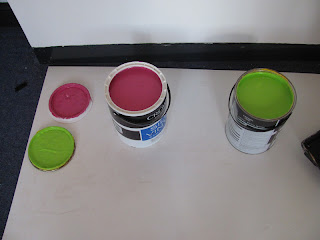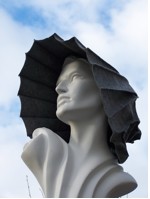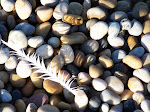I began this blog as a means of proving that I wasn't a technophobe and as a key tool when supporting students setting up in business or recording their thoughts for the HNC. Though it was really my critical diary for my MA. So without the enforcement of academic expectations I seem to have lapsed slightly. So where to begin.
LACE............
Friday, 30 November 2012
Saturday, 22 September 2012
Research Dissemination
As part of my HE work we have to undertake research work. So back to work and the second week I had to present my research practice along with several other tutors to our peer group. No pressure.
One of those late nighters later - I didn't fall flat on my face and my USB stick had saved the images in the right format. The presentation seemed to go well and it has given me the confidence to apply to present at more academic conferences and appreciate that the work I have done has value and relevance.
One of those late nighters later - I didn't fall flat on my face and my USB stick had saved the images in the right format. The presentation seemed to go well and it has given me the confidence to apply to present at more academic conferences and appreciate that the work I have done has value and relevance.
 |
| J Smith Esquire - Illuminated from Hot Heads Exhibition, Hat Works. |
Labels:
Hat Works,
hot heads,
j smith esquire,
Sharon Bainbridge
Back to Work
The shift from en vacance to day to day travail is often a tricky one......
From this:
to the M62 mmm.
But the key is looking for those bits of positivity.
fabulous Yorkshire skies.
From this:
to the M62 mmm.
But the key is looking for those bits of positivity.
fabulous Yorkshire skies.
Monday, 27 August 2012
Beginnings
Whilst in the process of decorating I had to take a piece of framed textile down and was surprised when looking on the reverse to see I had made it 15 years ago. This created many trains of thought.
I began my textiles journey when I moved to Yorkshire in 1996, initially in a morning adult education (remember the joys of those opportunities) then on a City & Guilds programme, I kept seeing pieces of felt and being eager to learn the process. I was fortunate to get a place on a weekend course at Bankfield Museum with renowned feltmaker Heather Belcher. A serendipitous time, June Hill was the curator at Bankfield at the time creating an innovative education programme and inspiring exhibitions. a great beginning on a new path.
 |
| Felt piece made at Bankfield Museum 1997 |
I began my textiles journey when I moved to Yorkshire in 1996, initially in a morning adult education (remember the joys of those opportunities) then on a City & Guilds programme, I kept seeing pieces of felt and being eager to learn the process. I was fortunate to get a place on a weekend course at Bankfield Museum with renowned feltmaker Heather Belcher. A serendipitous time, June Hill was the curator at Bankfield at the time creating an innovative education programme and inspiring exhibitions. a great beginning on a new path.
Labels:
Bankfield Museum,
Heather Belcher,
Sharon Bainbridge
Friday, 27 July 2012
The Art of Exhibition Labelling
My wonderful and talented (step) daughter, Agatha kindly joined my volunteer status for the exhibition and agreed to get into my head to decipher what look the exhibition graphics should have.
As a designer one is always aware of how difficult it can be to get the information from a client as to what they actually want. We all communicate in different ways and miss communication often happens, we are all too aware of that facial expression if our reading is slightly off course.
So it was really interesting to see how differently the process can be with a relative who can be on the same wave length and has the same visual language reference points, it is far easier.
Agatha had seen the space when visiting The Finishing Touch so knew the constraints and what the space was like.
We had a title - Hot Heads - Inspirational British Millinery and a mission to create a cutting edge exhibition so wanted the graphics and look emulate this but also not scare off regular museum visitors. Colour schemes were looked at and agreed quickly then it was the typeface.
Working in an art college and having relations in Graphic Design I understand the nuances of type to a degree, so I am fortunate, often one forgets that we are in a privileged space as many don't and graphic designers walk a fine line. I loved the font that was purchased for the logo, others were not so convinced.
I am so glad that they let us stick to our guns and that I was dogmatic in that this was right for the exhibition look, as it does work in putting across what the exhibition is about.
A great result down to a lot of very hard work and late night emails as the quality of images wasn't always right and some images were over deadline, a few more grey hairs!! A huge thank you to Agatha as she was incredible in her approach and determination and her wonderful designs.
As a designer one is always aware of how difficult it can be to get the information from a client as to what they actually want. We all communicate in different ways and miss communication often happens, we are all too aware of that facial expression if our reading is slightly off course.
So it was really interesting to see how differently the process can be with a relative who can be on the same wave length and has the same visual language reference points, it is far easier.
Agatha had seen the space when visiting The Finishing Touch so knew the constraints and what the space was like.
 | |
| The Finishing Touch Introduction Panel |
Working in an art college and having relations in Graphic Design I understand the nuances of type to a degree, so I am fortunate, often one forgets that we are in a privileged space as many don't and graphic designers walk a fine line. I loved the font that was purchased for the logo, others were not so convinced.
 |
| Hot Heads Graphics - copyright Aggie Bainbridge |
A great result down to a lot of very hard work and late night emails as the quality of images wasn't always right and some images were over deadline, a few more grey hairs!! A huge thank you to Agatha as she was incredible in her approach and determination and her wonderful designs.
 |
| Noel Stewart panel - design Aggie Bainbridge |
Next Stage of the Exhibition Process
 |
| Not the new exhibit, just more preparation. |
Setting up Hot Heads was an exciting process, daunting in that we didn't have all the hats! Being on the phone to one of the designer's PR's to check for the arrival of the hats, to be told that they were about to be selected and could we send a car to collect them, (from London)! Was definitely a surreal moment, especially when working so well with other designers. All a very interesting learning curve.
 |
| What shall we put where? |
 |
| so much to do |
 |
| Karen Henriksen box of stunning headwear |
 |
| A fascinating opportunity to look at other people's work |
 |
| Working out the best cases for the work - Zara Gorman |
 |
| Zara Gorman - sculptured wood |
 |
| Checking the locations for Edwina Ibbotson |
 |
| Close up of rolled fine straw flower - Rachel Trevor-Morgan |
Saturday, 21 July 2012
New Exhibition Begins
' I hold in general a belief that courage is the shortest route to the good life. As a matter of fact I believe courage is synonymous with the good life. I see fears as normal and rational in my life, but fear does sometimes try to hold me back and try to stop me from actions that make life rich and rewarding. To live a fully engaged life I feel I need to exercise some measure of courage. Courage to me is a willingness to try.' Waltraud Reiner, Australian milliner and inspirational tutor.
These words echo exactly how I felt when I drove to Hat Works ready to begin the next installation. Knowing that 'sticking one's courage to the sticking spot' (Macbeth) is so important to help us grow and learn, and as I have been rereading the Twyla Tharp book again, 'What was the worse thing that could happen' my family would still love me.
Quite a strange feeling to have the technician ask me where I wanted the cases to be? I realise that I am not quite there with the confidence of curator just yet as I didn't have a vision for it all. Or was it that my occasional feeling that winging it does sometimes work and gives new ideas take over. Cases were moved, lights installed and stripes painted. Our only real dilemma was that three of the milliners hadn't sent their hats..........As I reflect on this now after a very successful opening it seems quite funny because it did work out and you realise that there is usually a solution somehow, even if it had been to borrow a certain hat from Leeds Museum Archive.
These words echo exactly how I felt when I drove to Hat Works ready to begin the next installation. Knowing that 'sticking one's courage to the sticking spot' (Macbeth) is so important to help us grow and learn, and as I have been rereading the Twyla Tharp book again, 'What was the worse thing that could happen' my family would still love me.
 |
| empty cases at Hat Works, Stockport. |
 |
| Deciding where we need to put the cases |
 |
| Phew we have some of the hats - William Chambers - Latex Flower Head Piece |
 |
| Our stunning colours - courtesy of Graphic Designer Aggie Bainbridge |
 |
| Hats delivery from Rachel Trevor-Morgan |
Thursday, 19 July 2012
End of an Exhibition
I have written little on this blog about my work at Hat Works as Guest Curator, due to a variety of reasons. This began when on my MA helping out answering research questions and being an extra pair of hands, then led to a project for my final course work to curate an exhibition on Trimmings for millinery. It was a fantastic experience so as it all comes to be taken down before the next one is put up it was a good time to reflect on what I had managed, with that fear that i wouldn't be able to do as good a job next time.
 |
| Items from the Ribbon Case - hat from Hat Works archive |
 |
| Ribbon trims from Marie Kay |
 |
| A selection of ribboned hats from the Hat Works museum |
 |
| Stunning wood pieces from Emma Yeo in the New Materials case |
 |
| Rebecca Thomas, William Chambers and Marisa Groom, one of my favourite cases |
 |
| Fabric Trims a selection from the museum and Claire Spooner - Quaintrelle Millineryturban piece |
 |
| Mitzi Lorenz - Cloche |
 |
| Mitzi Lorenz - Orange melusine felt |
 |
| Vintage feathers - Hat Works collection |
 |
| Flower case |
 |
| Graham Smith Feathered bomb hat |
 |
| Audio coverage panel |
 |
| My exhibition opening - very proud - |
Close up of Mr Treacy's hat
I have spent many a lovely morning at Leeds Archive, it makes you stop and think and invites so many thoughts about the origin of objects and the lives they have had. I was invited to join the evening class students as they looked at feathered hats within the collection and were shown the damage the many bugs and creepy crawlies can do to feathered objects ( one of those itchy moments) a fantastic opportunity.
I had seen the Philip Treacy hat that the museum had had commissioned for their Ruffled Feather exhibition in 2010 and knew how much it had cost and the trials and tribulations. It was still a privilege to see it so close and more importantly for myself to see its construction, how was the wire inserted, what was the ribbon that had been used? ( A stretchy velvet) How were the feathers added? Smaller quills support the main plumage. and what was the twist made of? It is so strange that the hat will never be worn, just live i its grandiose box and come out for exhibitions, an intriguing museum conundrum.
I was very fortunate that when I designed a piece for the exhibition I was approached along with Justine Bradley-Hill for the museum services to purchase my hat for the collection, a real honour.
But a funny feeling to have it there for others to critique and examine, all god experience.
 |
| A flavour of the archive a place of magic and dreams |
I had seen the Philip Treacy hat that the museum had had commissioned for their Ruffled Feather exhibition in 2010 and knew how much it had cost and the trials and tribulations. It was still a privilege to see it so close and more importantly for myself to see its construction, how was the wire inserted, what was the ribbon that had been used? ( A stretchy velvet) How were the feathers added? Smaller quills support the main plumage. and what was the twist made of? It is so strange that the hat will never be worn, just live i its grandiose box and come out for exhibitions, an intriguing museum conundrum.
 |
| The underside of the Philip Treacy hat-key for every milliner to see how it was done |
 |
| Close up on centre twist - Philip Treacy feathered hat |
 |
| Ostrich feathers on Victorian Bonnet |
 |
| My Ruffled Feather hat Property of Leeds Museum and Galleries - Very strange to have one's hat brought out to be examined. |
But a funny feeling to have it there for others to critique and examine, all god experience.
 |
| hat by Justine Bradley-Hill |
 | |
| One so much wants to put the Philip Treacy hat on your head, strange that it will never be worn. |
 |
| Stunning feathers - though not quite sustainable |
A trip to Manchester
I was fortunate to go to Manchester for a training morning last month, looking at how objects in museums and every day life tell stories and enable history and ideas to be remembered. It was fascinating, looking at how a box of Kellogs Cornflakes could link back to the oldest horse, whose skull is in the museum, I will let you mull on that one. How as someone involved in museums or exhibitions can create new lateral ways to tell stories with objects. Something i loved as ever is being behind the scenes in a museum, there is that spark of wanting to find out more.
This was a really fascinating garment as it was practical, beautifully made, perfect design.
 |
| Inuit sealgut coat (kamleika)-pre 1925 |
 | ||
| a waterproof layer that would be worn over a seal skin coat |
 |
| Couldn't resist the taxidermy! |
 |
| Every time i see the garden at Manchester Museum I covet it. |
 |
| loved these - just near Victoria Station, really made me smile |
Subscribe to:
Comments (Atom)















